There was a point, when I was watching Meghe Dhaka Tara, that I was reminded of another much-acclaimed Indian classic, Pyaasa. A man, an artiste (a singer, not a poet, as in Pyaasa) wanders along on a grassy patch of land, singing. Far beyond is the railway track; around him are shady trees, a path, solitude. Here is a man practising his art, being one with nature, without a care for the world around him.
It reminded me of Vijay (Guru Dutt) in Pyaasa, reciting a poem as he lies on the grass. Far away from the world, even if not literally, because the world intrudes—brutally. Also, I was reminded of Vijay, because (like Vijay), the singer in Meghe Dhaka Tara, Shankar (Anil Chatterjee) does not have a job: he depends on his family for his upkeep. A family which derides him for being jobless, for sponging off them.
There the resemblance ends, because Shankar is not the protagonist in Meghe Dhaka Tara; it is his sister Neeta ‘Khuki’ (Supriya Choudhury) who is the focus of the story, and she is nothing like the protagonist of Pyaasa. She does not sit around abusing the world and criticising it for giving her the short end of the stick. She does not mourn and indulge in one round of self-pity after another. She is nothing if not hardworking; hardworking, self-sacrificing, to the point of being a pushover. She has little time to weep over the past.
Set in a small, shabby refugee camp (though it’s never explicitly stated as being such) on the outskirts of Calcutta, Meghe Dhaka Tara revolves around Neeta and her family. A family of six, all of them adults, and all obviously well-educated, genteel—and equally obviously, poor. Not poor as in having to scavenge, but poor as in having to face the taunts and the ungentle reminders of the shopkeeper from whom they take credit.
Their father (Bijon Bhattacharya) is a teacher, a mild-mannered man who quotes from the classical English poets and gives the impression of wanting to run away from the haranguing and turmoil of daily life. Much of this angst is due to his wife (Geeta De), a bitter and tense woman who dotes on her two youngest children and abuses the two elder ones.
The eldest of the offspring is Shankar, who has been learning Hindustani classical music and spends all his time in riyaaz. Beside the train track (with the sound of a passing train drowning out his voice every now and then), wandering through the grass, at home. Shankar doesn’t have a job and has no desire to even try for one. He is very certain of his talent, and knows that someday he will make it big; but his joblessness, in the meantime, makes him an object of contempt for most people. The shopkeeper, for instance, keeps mocking Shankar for being the eldest son but living off his sister’s earnings. Shankar’s mother, too, leaves no opportunity to tell him off, and to curse him. What good is a son like this?
Not that their mother has a kind word even for the daughter who is responsible for keeping the family fed and clothed. Neeta works as a tutor, and her tuition earnings are what primarily finance the family; their father’s earnings are too little, and too spent in other non-essential expenses: a subscription here, a gift to a passing minstrel there. Neeta’s earnings are greedily and quickly gobbled up: her two frivolous younger siblings, both of them in college, have no compunctions about taking away her last few annas to buy themselves things. Montoo (Dwiju Bhawal), for instance, is more interested in sports than in studies, and wants a new pair of good football boots, with spikes.
And his sister Geeta ‘Geetu’ (Geeta Ghatak) is as equally uninterested in studies as Montoo; she would rather pretty herself up and read magazines all day long.
Their mother is indulgent towards Montoo and Geeta; their wants must be met, their desires fulfilled. Instead, she accuses Neeta of spending all her money on herself, not having a care for them.
Finally, there is Sanat (Niranjan Ray). Sanat was once a student of Neeta’s father’s, and he’s on very friendly terms with the entire family. Especially Neeta, with whom he’s in love (he is the one, in fact, who gives her the epithet of ‘megha dhaka tara’—‘the cloud-capped star’—in a love letter at the start of the story; he uses it to refer to her sweetness and kindness, which is shadowed by the poverty and selfishness of those around her). That Sanat and Neeta are in love is an open secret: everybody knows it, including her parents and his neighbours.
But there are obstacles to Neeta and Sanat getting married, even though they dream about it. He does not have a job; he’s a scholar—a very accomplished and intelligent one doing research on some complicated theory in pure physics—and she knows that if she were to get married and leave her home, her family will be left with no means to support themselves. They cannot possibly survive on just her father’s income.
And that, when the old gentleman slips and falls on the railway tracks, too comes to an end. With his accident and his getting bedridden, Neeta’s last hopes of being able to get away and finally find some happiness of her own too evaporate.
What I liked about this film:
The completeness of it. When I was younger, I would probably not have been so appreciative of a film that is so deeply tragic, and in which the protagonist, for all her goodness and ever-cheerful self-sacrifice, ends up with next to nothing. Now, I like to think I have matured a bit, so despite the sadness of it, I could not help but be awed by Meghe Dhaka Tara. By Ritwik Ghatak’s direction, by the music, the acting, the story. There is nothing here I didn’t like, but some elements, in particular, need special mention when it comes to what I especially liked.
Firstly, the characterization. Barring the selfish and greedy Geeta, nobody in the film is completely black or white (and Geeta too isn’t completely heartless). Neeta’s mother, for instance, for all the barbs she flings at Neeta, does, now and then, in a moment of remorse, curse her own tongue for being so brutal. Life has made me this way, she mourns.
Her husband, Neeta’s father, a kind man who seems genuinely appreciative of the effort Neeta makes to keep the house running, is yet not perfect. He has little concept of controlling expenses, and is a bit of a milquetoast: he sees his wife treating Neeta harshly and unfairly, but does little to intervene. And by the time he does intervene, it’s too late.
The most interesting secondary character, for me, is Shankar. This is a man who seems, at first glance, to be merely utterly selfish and shameless: the way he begs Neeta for a few annas so that he can get a shave is embarrassing. But this is also the brother whom Neeta admits happily that she loves, and who—it’s equally obvious—loves her, too. He may take money from her, but he also chides her, calling her idiot, for letting the family ride roughshod over her. The interactions between Shankar and Neeta are among the most heart-warming in the film, because this is the one member of her family with whom Neeta seems most at ease: she does not need to maintain a façade of acceptance and quiet calm before him. And their very last scene together in the film is heart-breaking.
Neeta herself is a memorable character—one in whom I could see traces of people I have known. A person who, because of circumstances, has to take on more than her share of a burden, and who, because of her inherent docility and generosity, ends up being ‘exploited’ (the exact term Shankar uses to describe Neeta’s condition). To the outsider, it would seem as if Neeta is spineless, allowing her selfish family to use her without giving her anything in return, not even thanks. But, as she tells Shankar, she does this because she loves them all, and she knows that (even though they may be too shy to say it), they love her too.
Neeta’s love—for her family, for Sanat—eventually ends up with her being too selfless for her own good, leading to her downfall. But in the process, another facet of Neeta is revealed: a woman who realizes that the very people who once depended on her have now become so independent, so sure of themselves, that they have no further need of her—and that they have no compunctions about turning their backs on her. Her good nature will not allow her to cry over their desertion of her, but she is human, after all, and she cannot remain completely impassive.
Besides the characterization, I also loved the way everything fits in, the crisp editing and the fine focus of the story. There is nothing here that is superfluous; nothing that could easily have been done without. Even the songs (and which old Indian film would be complete without songs?) become part of the narrative: one is Rabindrasangeet which Shankar teaches Neeta at her request, at a time when she is in deep distress; another is a song sung by a minstrel who comes by. Mostly, though, the songs are those sung by Shankar as he does his riyaaz: sublime pieces of classical music, sung playback by Pandit AT Kanan.
Lastly: the look of it. The frames, the light and shade, the stark reality of sudden, unforgivingly extreme closeups.
If you haven’t seen Meghe Dhaka Tara so far, I strongly urge you to. It’s worth watching.
And yes, before I end this post: happy birthday, Supriya Choudhury! Ms Choudhury, one of the stalwarts of Bengali cinema, was born on January 8th (she shares a birthday with me, though she’s 38 years older than I am).



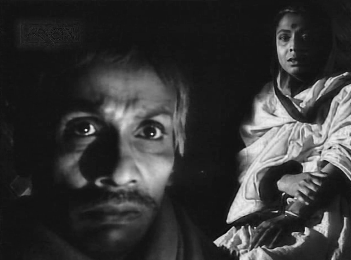
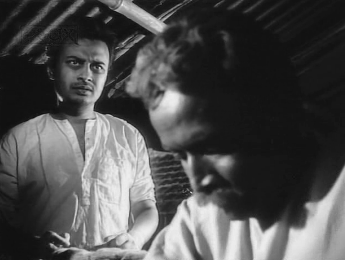
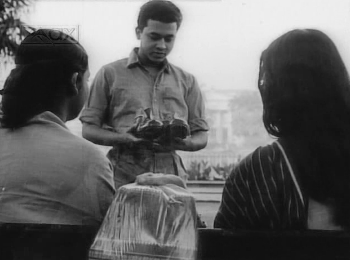
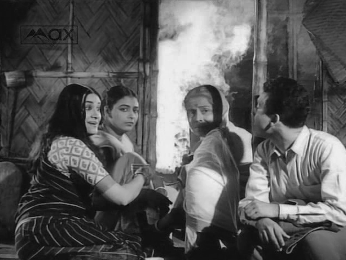
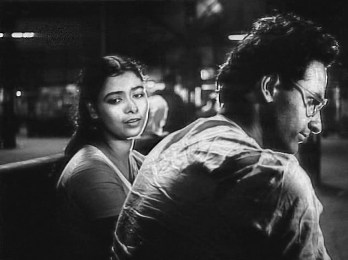

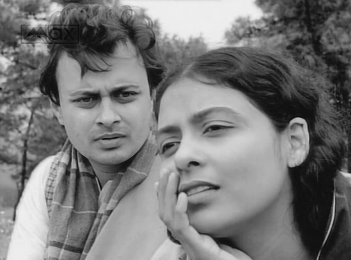


I am an ardent fan of Ghatak’s films. This and Komal Gandhar are my favorites….the stark reality, the splendid juxtaposition of audio and visuals are his forte……Thanks for this good review…..
LikeLike
I must admit that I’ve never watched any of Ghatak’s films before, though of course I’ve heard a lot about his work. Now that I’ve finally watched one of his films, I shall make it a special point to see more. Meghe Dhaka Tara was memorable. Brilliant.
LikeLike
Happy Birthday and wishing you many happy returns of the day…..your excellent articles on world of cinema and eateries are outstanding.
LikeLike
Thank you so much!
LikeLike
Good Morning Beti,
Wishing you Happy Birthday and many happy returns of the day, more prosperous, wonderful, cheerful and peaceful.
ENJOY
https://www.youtube.com/watch?v=L0JPxFQUVW4
A very good review. but Pyaasa is a classic by itself and an all time best listed as one of the top 100 movies produced in India. Also it is a part of Guru’s own life story.
Blessings to you from Uncle
LikeLike
Thanks a lot. I hadn’t known Pyaasa had been listed as one of the top 100 movies made in India, though I’m not surprised – it is a superb film, and Time Magazine did list it as one of the world’s top 100 films. It’s a favourite of mine, but comparing Meghe Dhaka Tara to Pyaasa, I can’t help but think that this film ranks alongside Pyaasa.
LikeLike
Good Morning beti,
The following is only for information and nothing more…..
Pyaasa is an all time classic and is an inspiration to many such kind of movies as well as literature relesed in 1956. It has may positive points starting from the the story with full command of the romantic line generated in the depression atmosphere given by great writer Abrar Alvi.
And to match the context S.D Burman has all the laurels who created a music of different kind. All the songs in that movie are a class by themselves written by great Sahir Ludhianvi.
And the more philosophical or a truth in life, “Ye Duniya Agar Mil Bhi Jaye” is a masterpiece followed with “Jaane Woh Kaise Log”, sung by Great Rafiji and Hemantji, but not ignoring Geethaji’s contribution.
Every actor did their best in this movie.
I read, Sahir Ludhianvi as well as Guruji have experienced Love failure and a bit of that sour touch could be found in this movie.
Above all the wonder work done through the magic lense by Great Late Sri V.K. Murthy the Director of Photography is ever lauded. His lighting effects given to the scenes in this movie stands outstanding.
https://www.youtube.com/watch?v=EhDCAmXKBBs
https://www.youtube.com/watch?v=BddNciwWCBQ
Click on link below for some information on Guruji..
http://creative.sulekha.com/guru-dutt-maestro-director-and-his-death-mystery_364993_blog
All the best and blessings to you.
Uncle
LikeLike
Yes, of course. I’ve written several posts that touch upon Pyaasa: scenes from the film, for instance; and one song devoted completely to the songs of the film, their symbolism and more.
LikeLike
Madhu,
Very lyrical review. I went over to YT to see the film before I commented. But couldn’t find one with English/Hindi sub-titles. I might nevertheless watch the Bengali film as it is. I came back just to compliment you and thank you for the great review of a great film.
AK
LikeLike
Thank you so much, AK! Yes, no subtitled version of this is available on Youtube; even the DVD I managed to get has rather sketchy subtitles – they come and go. But not enough to really ruin the film. I hope you are able to watch it, and that you like it as much as I did.
LikeLike
Good that you saw Meghe Dhaka Tara. It is a seminal film, and definitely the most commercially successful film of Ghatak. Ghatak, as you may know, was from East Bengal, and most of his films have, in one way or the other, focused on partition and its aftereffects. Regarding the songs – Je raate more duar guli was probably the most poignant use of a Rabindra Sangeet in films. The close ups coupled with light and shade complement the lyrics beautifully.
Two interesting connections – I cannot help but add some trivia – Geeta Ghatak sings for Supriya here :). Geeta was a music teacher in Calcutta, and also taught at South Point High school for some time where students used to pass snide remarks about her portly figure. And the traditional Hamswadhani phrase “Lagi lagan” , sung by A T Kannan in the film is the progression Salil Chowdhury uses in “Ja tose nahin bolun kanhaiya” (Parivaar).
LikeLike
Thank you for the comment, and especially for the trivia! I had no idea. How interesting that is. And now I must go back and listen to Lagi lagan again. That did sound familiar to me when I heard it, but I put it down to it (as I supposed) as being a result of having heard the phrase before. I hadn’t realized it had a connection to Jaa tose nahin boloon Kanhaiyya.
LikeLike
Wish you a very happy birthday Madhuji. Meghe Dhaka Tara seems to have been the inspiration for quite a few movies. For instance, the Tamil movie, Aval Oru Thodar Kathe in 1974 and on which the Hindi movie, Jeevan Dhara (1982) was based.
Our Indian producers and the audience too seemed to have a proclivity to movies which had a noble soul sweating it out while the other family members had a whale of a time. The Girish Karnad, Hema Malini movie, “Swami”, is one such example which immediately comes to mind.
LikeLike
Thank you so much! I hadn’t realized that there were other movies inspired by this one, but I’m not surprised – this is a timeless theme, and one that would be recognized by people everywhere. I agree, too, with your assertion about Indian audiences and film makers having a “proclivity to movies which had a noble soul sweating it out while the other family members had a whale of a time.” (what a brilliant phrase! It made me grin). I’ve not seen Swami (wasn’t that the one with Swaroop Sampat in it too? With Pal bhar mein yeh kya ho gaya?), but I’ve seen several others along the same lines. Most, though, in classic Hindi cinema style, neatly straighten the balance and have the noble soul being lauded at the end and living happily ever after.
LikeLike
Apologies for intruding, but Jeevan Dhara , which also had a Bengali Original in Kobita (with some lovely music by Salil) was not exactly inspired by MDT. The funda of a girl working to support her family was pretty much a common thing in Bengal after the partition. It is still a norm in many BPL households, especially in the border areas. .
Swami is in no way related to MDT. That’s a typical Sarat Chandra story, written much before Shaktipada Rajguru wrote MDT, where a girl (Shabana azmi in the film) gets married to a widower. In this case, the widower (Girish Karnard) is a step son extremely who, apart from being the sole bread earner, is also devoted to the family, notwithstanding the machinations of his step mother (Shashikala). Nothing extraordinary about it, in fact, multiple marriages by design / by deaths of the wife during childbirth / etc. was in vogue in India and Bengal in the 19th / early 20th century, esp in rural areas.
LikeLike
typo – In this case, the widower (Girish Karnard) is a step son who, apart from being the sole bread earner, is also extremely devoted to the family, notwithstanding the machinations of his step mother (Shashikala)
LikeLike
Thank you for that clarification. What, by the way, is BPL?
LikeLike
Below Poverty Level
LikeLike
Ah. Should have remembered that. When I read it, all that was coming to my mind was Bengal and Partition.
LikeLike
hehehe.. Happy belated birthday :)
LikeLike
Thank you! :-)
LikeLike
Dear Madhu, happy birthday: and thanks for this well-beloved movie which I plunged in once again! I was again stung by its nostalgic poetry and poignant beauty. One little point: I wouldn’t say myself that Neeta is “too selfless for her own good” as you do, because I think she’s a symbol of a love that goes beyond everything, and Ghatak’s stand is precisely that such love indispensable in a doomed world. But well, artistic differences…!
All the best, yves
LikeLike
Thank you, Yves! And, you must know: one major reason I wanted to watch this film was because of your review of it. I remembered reading it and being affected by it.
I suppose my assertion that Neeta is ‘too selfless for her own good’ stems from the fact that her character reminded me very strongly of a very close relative whose life in many ways mirrors Neeta’s. Seeing how this person (my relative) was used (there’s really no other word for it) by her own siblings and parents, all because she was too sweet and loved them a lot, distresses me. Eventually she got so fed up that she cracked under the pressure and ended up telling them that enough was enough, but while it lasted, it was heartbreaking to see what she was going through because of her love for them and her selflessness.
I can see, though, that you (and Ghatak) might have had a different point to make. :-)
LikeLiked by 1 person
Supriya Chowdhury was superb in this one. Her last words, “Dada aami kintu baachete cheye cheellam”. (Dada I wanted to live) sort of sums up the film. A person’s intense need for family as well as the need to connect with other people whether they are relatives or friends comes through in the film. When her brother comes to meet her and tells her about their little nephew, she listens eagerly and then the cry, she too wanted to live and be part of a family. Though this is not explicitly shown in the film, it is implicit. It definitely tugs at one’s heartstrings.
LikeLike
“When her brother comes to meet her and tells her about their little nephew, she listens eagerly and then the cry, she too wanted to live and be part of a family.”
Very true, Shilpi. And that last dialogue of hers is really heart-wrenching. I had tears in my eyes in that scene; more even in the one that follows, when Shankar sees a passing woman in the basti, stopping to take off a broken chappal, then going slowly on her way… his sorrow is heartrending.
LikeLike
In retrospect, as an adult or should I say as a lady almost close to being called a senior citizen, I am able to better understand some of the scenes. What is touching about the end is that despite being cheated by her lover and sister, she is so eager for a normal family life, that she holds no grudge she just wants to be with her family.
LikeLike
Yes, Shilpi. The fact that she doesn’t hold any grudges against her family speaks volumes about her. I think that also emerges in other ways – for instance, the way she separates herself from the rest of the them so that they don’t realize she’s ill. While other people (mostly Westerners), even while praising this film, have called it melodramatic, I think (possibly because I have seen the heights to which melodrama can go in Hindi cinema?) don’t think this is really melodramatic. Melodrama, most of the time, fails to touch me. This touched me deeply.
LikeLike
I watched this in my teens and was quite depressed with the film – it just seemed so martyred, and ‘what women do’. I suspect my maturity level hadn’t caught up with the beauty of the film; I know I didn’t appreciate it much then.
I’d like to watch it again to see if a more-mature me (ha!) reacts differently, but not for some time. I watched Wendy and Lucy yesterday, and was in tears at the end of it. Not a good feeling.
And a very happy birthday to you, my dear soul sister. May your ife be long, and filled with happiness.
LikeLike
Thank you, Anu! (And you know it’s not these greetings, here on my blog, but elsewhere too – thank you!)
I haven’t watched Wendy and Lucy. In fact, I don’t even think I’ve heard of it. Depressing, eh?
LikeLike
Wendy and Lucy is an Indie film; beautiful but oh, so sad. Especially the ending.
LikeLike
Hmm. Having already watched Meghe Dhaka Tara recently, I shall perhaps give this one a miss for now. I could do with something happier.
LikeLike
Speaking of sad movies, I mostly avoid them like the plague. Right now, I’m avoiding two recent Hollywood movies, one a blockbuster and the other an award winner. However, when I need a good cry I watch the last scenes from “Cinema Paradiso” & “Goodbye Mr. Chips” (1939) and a few chosen scenes from “Dr. Zhivago” (1965). Admittedly, some of these are shamelessly emotionally manipulative but they work.
And a belated happy birthday to you.
LikeLike
Of all of those, the only one I’ve watched is Dr Zhivago – and I remember very little of it. Goodbye Mr Chips I’ve read, and have never wanted to watch it, because I’m pretty sure I wouldn’t be able to handle it.
Somehow, I never need movies to give me a good cry – life manages that for me fairly well. ;-)
Thank you for the wishes!
LikeLike
Oh I can cry plenty without help too. But sometimes when it’s too much, the tears just won’t come. But life is still mostly good, thanks to books and movies. :)
LikeLike
“But life is still mostly good, thanks to books and movies. :)”
With that, I agree wholeheartedly! :-)
LikeLike
Meghe Dhaka Tara is to Ritwik Ghatak as Charulata is to Satyajit Ray – his most complete film. I too loved the scenes depicting the interactions between Shankar and his sister. The love they had for each other comes across very convincingly on the screen. I also loved the acting of Bijon Bhattacharya as the father – his exclamations from time to time of ‘Dekho Kando’ (roughly translated as ‘Look what’s going on’) were very endearing. I never get tired of watching this movie despite it’s tragic end.
BTW, have you watched Ganga by Rajen Tarafdar? This movie also featured Geeta Ghatak and Niranjan Ray. In this movie Niranjan Ray plays a man without a backbone. In Ganga he has a fiery spirit. And he had the best physique among Bengali actors pre-Mithun Charavarty. But you have to watch Ganga to see him shirtless.
LikeLike
I haven’t watched (and hadn’t even heard of) Ganga, but your description of it sounds very enticing. I shall put it on my wishlist, and hope that I’ll be able to get hold of it soon. Thanks for the recommendation!
Yes, Bijon Bhattacharya was excellent, too: what affected me the most was the way his helplessness comes across at the same time as his realization that what’s going on around him isn’t right. Good scripting, good characterization, and also, most importantly, good acting.
Your reminding me of Charulata makes me want to watch it again. Such a wonderful film.
LikeLike
Do watch Ganga. It’s on youtube. It also has a superb score by Salil Chowdhury.
LikeLike
… and if there was any hesitation, Salil Choudhary is the clincher. ;-) I love that man’s music. Will watch, thank you!
LikeLike
Happy birthday to you madhu. I saw this in the good old DD daays as I think part of 75 years of Indian cinema or some such occasion. saw lot of movies including 3 of Ghatak- Komal gandhar was the second while I don’t recollect the third. Like some of the others in the comment section – I was quite young and found it too depressing to my liking. May be The film needs to be revisited but I still don’t dig stories of supreme sacrifice , burning out like a candle ,sob sob stuff.I also thought that he made a virtue of suffering. Oh yes it did remind me of Aval oru thodarkathai as well. Kb was adept at adapting works from far and wide.
All in all I don’t think I want to see it again.
LikeLike
Thank you for the greetings!
I can well understand your reluctance to rewatch the film. There are countless films of this tragic style that I watched when I was far too young (sometimes, not even tragic, but just not conforming to the formulaic Hindi film model I’d become used to), which I wouldn’t want to watch again.
With Meghe Dhaka Tara, I somehow got the idea that Ghatak wasn’t making a virtue out of suffering, just depicting a scenario that isn’t rare. Also (perhaps because I’m more mature now and can see nuances that would have missed me when I was younger), the finely etched characters of the people in this story helped bring them alive – it never seemed as if I was watching a ‘sob story’. Tragic, yes, but too real and close to life to seem impossibly sad.
But then, that’s my view. :-)
LikeLike
Belated happy birthday Madhu jee !
As regard Ritwik Ghatak, many critic’s regard him an even better filmmaker than Satyajit Ray and ‘ meghe dhaka tara ‘ proves that the statement is not completely out of place! The film is part of a trilogy of films indirectly depicting the life of erstwhile East Bengal refugees. The other two being ‘ Komal Gandhar ‘ and ‘ subarna rekha ‘, both of which are outstanding movies.
LikeLike
Thank you! I agree with you that, having watched Meghe Dhaka Tara, one can see why critics would regard Ritwik Ghatak as a better filmmaker even than Ray – I certainly thought that the finesse of this film ranked on par with some of Ray’s best films, like Charulata or (one of my favourites) Kapurush.
I had heard about the other two films that formed this trilogy, but haven’t watched them yet. Will do so now.
LikeLike